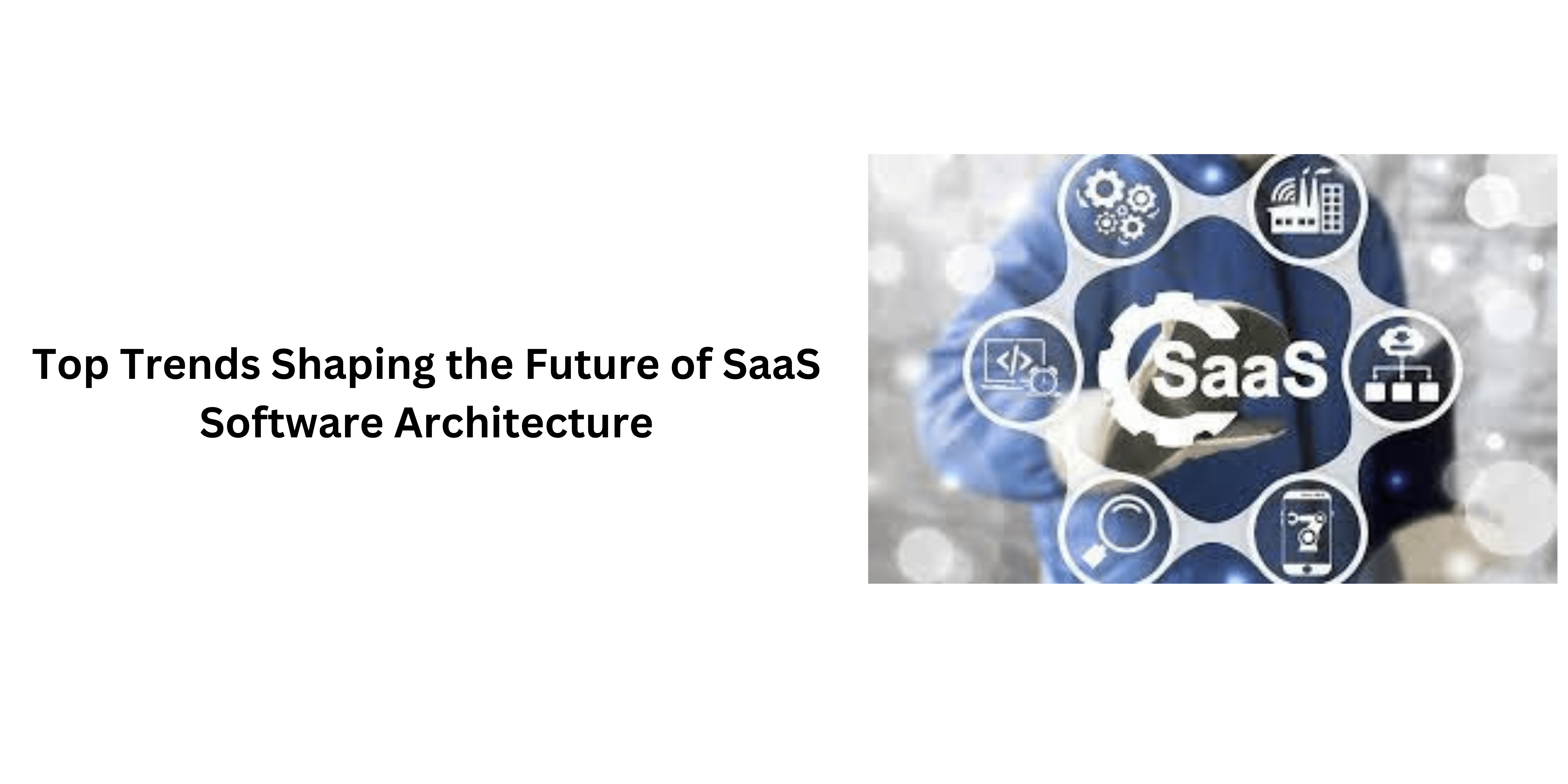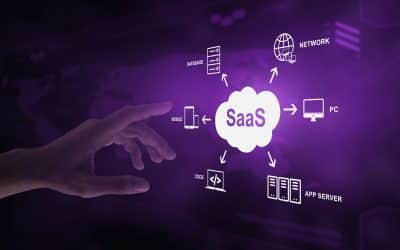In the dynamic landscape of Software as a Service (SaaS), the future is intricately shaped by a myriad of technological trends, each contributing to the evolution of software architecture. Embracing the modular revolution, microservices take center stage, while serverless computing reshapes scalability paradigms. Artificial Intelligence (AI) becomes an integral part, infusing SaaS software development with smart and adaptive capabilities. The rise of containerization and event-driven architecture amplifies deployment efficiency and real-time responsiveness.
From data mesh frameworks to low-code platforms, these trends promise a future where SaaS is not just a service but a dynamic, ever-evolving ecosystem. This exploration encompasses security advancements, sustainability initiatives, and the fusion of emerging technologies, offering a glimpse into the intricate tapestry defining the future of SaaS software architecture. As the industry continues to innovate, these trends collectively herald a new era of agility, intelligence, and user-centricity in the realm of SaaS.
Serverless Computing Revolution
The Serverless Computing Revolution marks a transformative paradigm shift in the world of software architecture, redefining how applications are developed, deployed, and scaled. Unlike traditional server-based models, serverless computing eliminates the need for developers to manage the underlying infrastructure, allowing them to focus solely on code and functionality. In this model, applications are broken down into smaller, independent functions, commonly referred to as serverless functions, that are executed in response to specific events or triggers.
This event-driven approach brings unprecedented flexibility and scalability, as resources are dynamically allocated based on demand, effectively reducing operational overhead and costs. Serverless architectures leverage the cloud to automatically handle the execution, scaling, and maintenance of functions, enabling developers to build more efficiently and deploy at a faster pace. The serverless revolution is not merely a technological evolution; it represents a fundamental change in how organizations approach software development.
It fosters a more agile and responsive development environment, allowing businesses to focus on innovation rather than infrastructure management. Furthermore, the serverless paradigm supports microservices architecture, contributing to modularity and scalability. As organizations increasingly embrace serverless computing, they gain the ability to scale applications seamlessly, respond rapidly to changing demands, and optimize resource utilization, ultimately propelling them into a new era of streamlined, cost-effective, and highly scalable software development. The Serverless Computing Revolution is more than a trend; it’s a fundamental shift towards a more efficient, scalable, and agile future in software architecture.
AI Integration in SaaS
The integration of Artificial Intelligence (AI) into Software as a Service (SaaS) heralds a transformative era, revolutionizing how applications operate, interact, and deliver value. AI’s incorporation into SaaS ecosystems empowers applications with advanced capabilities, ranging from intelligent automation and predictive analytics to natural language processing and machine learning.
One of the profound impacts of AI in SaaS lies in its ability to enhance user experience through personalized recommendations, adaptive interfaces, and context-aware functionalities. As organizations harness the power of AI-driven development, decision-making processes become more data-driven and informed. Machine learning algorithms, integrated seamlessly into SaaS applications, enable adaptive behavior, allowing systems to learn and evolve based on user interactions and data patterns. Moreover, AI integration in SaaS extends beyond user-facing features, permeating backend operations with automation, optimizing resource allocation, and improving overall system efficiency. The ability to process and analyze vast amounts of data in real-time enables SaaS applications to offer dynamic and responsive functionalities, making them indispensable tools in today’s fast-paced digital landscape.
As businesses navigate the complexities of evolving markets, AI in SaaS acts as a catalyst for innovation, enabling organizations to stay ahead by extracting actionable insights, automating repetitive tasks, and fostering a new era of intelligent, data-driven SaaS solutions. In essence, the synergy between AI and SaaS not only amplifies the capabilities of software applications but also defines a future where intelligent, adaptive, and user-centric technologies seamlessly integrate into the fabric of everyday business operations.
Containerization Boom
The containerization boom has emerged as a revolutionary force, reshaping the landscape of custom software development and deployment. At its core, containerization encapsulates applications and their dependencies into portable, lightweight units known as containers. These containers ensure consistency across diverse environments, bridging the gap between development, testing, and production stages. Spearheaded by technologies such as Docker and Kubernetes, the containerization boom addresses challenges associated with software deployment, offering a standardized and efficient solution.
Containers enable developers to encapsulate applications with all necessary components, including libraries and configurations, ensuring seamless deployment across various infrastructure environments. This portability fosters a paradigm shift, allowing applications to run consistently irrespective of the underlying infrastructure, from local development machines to cloud-based servers. Furthermore, container orchestration tools like Kubernetes streamline the management and scaling of containerized applications, facilitating efficient resource utilization and automating deployment processes. The containerization boom not only enhances agility and scalability but also accelerates the development lifecycle, enabling rapid iteration and continuous integration/continuous deployment (CI/CD) practices.
As organizations increasingly embrace microservices architectures, containerization becomes a linchpin, facilitating the modularization of applications into smaller, independently deployable units. In essence, the containerization boom is not merely a technological trend but a transformative force propelling software development into an era of enhanced portability, scalability, and streamlined deployment workflows, marking a pivotal shift in the way applications are built, shipped, and scaled.
Edge Computing in SaaS
Edge Computing in Software as a Service (SaaS) is redefining the dynamics of data processing and delivery, ushering in a new era of real-time responsiveness and efficiency. Unlike traditional cloud computing models, where data is processed in centralized data centers, edge computing distributes computing resources closer to the source of data generation, reducing latency and enhancing performance.
In the context of SaaS, this paradigm shift brings about transformative implications for applications and services. By strategically placing computing resources at the network edge, edge computing in SaaS minimizes the distance data needs to travel, enabling quicker processing and immediate responses to user interactions. This proves particularly crucial for latency-sensitive applications, ensuring a seamless and responsive user experience. Edge computing also addresses bandwidth challenges by processing data locally, reducing the need for constant communication with centralized servers. This not only enhances the overall efficiency of SaaS applications but also conserves network resources. Moreover, edge computing in SaaS supports decentralized data processing, contributing to improved data privacy and compliance.
As the Internet of Things (IoT) and connected devices continue to proliferate, edge computing becomes instrumental in managing the massive influx of data generated at the edge of networks. In essence, the integration of edge computing into SaaS architectures signifies a departure from the conventional cloud-centric approach, unlocking a realm of possibilities where applications operate at the speed of real-time, offering users a more responsive, efficient, and decentralized computing experience.
Event-Driven Architecture
Event-Driven Architecture (EDA) stands as a transformative paradigm in software design, fundamentally altering how systems respond to and process events, leading to increased flexibility, scalability, and responsiveness. At its core, EDA revolves around the generation, detection, and reaction to events, which can range from user actions and system notifications to changes in external data sources. In contrast to traditional request-response architectures, EDA allows systems to operate in a loosely coupled manner, where components communicate asynchronously through events. This decoupling enhances modularity, enabling each component to function independently while reacting to relevant events in real-time.
EDA’s significance extends across various domains, especially in the context of scalable and resilient applications. By embracing an event-driven approach, systems can adapt dynamically to changing conditions, responding to events as they occur rather than relying on predefined sequences. Moreover, EDA is instrumental in facilitating microservices architectures, where individual services communicate through events, fostering a modular and agile development environment. The integration of EDA in SaaS solutions ensures that applications can seamlessly handle diverse, unpredictable workloads while maintaining a high level of responsiveness.
Additionally, EDA aligns with the principles of serverless computing, enabling efficient and cost-effective resource utilization as components scale based on event-triggered demands. As organizations increasingly recognize the advantages of real-time responsiveness and adaptability, Event-Driven Architecture emerges as a cornerstone in shaping the future of software design, offering a robust foundation for scalable, modular, and agile systems that can effortlessly navigate the complexities of modern computing landscapes.
Data Mesh Frameworks
Data Mesh Frameworks represent a revolutionary approach to data architecture, addressing the challenges posed by the exponential growth of data in contemporary business environments. Unlike traditional monolithic data architectures, Data Mesh embraces a decentralized model, recognizing data as a product and applying principles of domain-driven design and product thinking to its management.
The framework promotes the formation of domain-oriented, self-serve data teams within an organization, each responsible for a specific domain of data. This approach mitigates the bottlenecks and complexities often associated with centralized data governance, enabling teams to independently manage and evolve their data products. Data Mesh emphasizes the use of well-defined APIs for data access, fostering a culture of data collaboration and interoperability across different domains. Furthermore, the framework advocates for the implementation of a federated data infrastructure, where data products are treated as first-class citizens and can be discovered and accessed seamlessly across the organization.
By decentralizing data responsibilities and promoting a culture of data ownership, Data Mesh Frameworks offer a scalable solution to the challenges of data management, enabling organizations to adapt to the demands of modern, data-driven business landscapes. As enterprises grapple with the complexities of big data, Data Mesh emerges as a strategic and innovative approach, facilitating a more agile, collaborative, and scalable data ecosystem that aligns with the principles of decentralized ownership and domain-centric data thinking.
DevOps and Continuous Integration/Continuous Deployment (CI/CD)
DevOps, coupled with Continuous Integration and Continuous Deployment (CI/CD), forms a synergistic approach reshaping the landscape of software development and deployment. DevOps is a cultural and operational paradigm emphasizing collaboration and communication between development and operations teams. In tandem with CI/CD, it streamlines the software delivery lifecycle by automating and integrating the processes of code integration, testing, and deployment. Continuous Integration involves regularly merging code changes into a shared repository, automatically triggering build and test processes to catch integration issues early.
Meanwhile, Continuous Deployment automates the release of code to production environments after successful testing. Together, DevOps and CI/CD break down silos, fostering collaboration and accelerating the pace of software delivery. This approach promotes agility, as developers can release new features and updates more frequently and reliably. Automation is a cornerstone, reducing manual errors and ensuring consistent and repeatable processes. The integration of CI/CD pipelines within a DevOps culture allows organizations to achieve faster time-to-market, improve product quality, and swiftly respond to changing business requirements.
Moreover, the continuous feedback loops inherent in this approach facilitate continuous improvement, allowing teams to iteratively enhance processes and deliver higher value to end-users. In essence, DevOps and CI/CD represent a fundamental shift towards a more collaborative, automated, and iterative software development and deployment methodology, fostering an environment where speed, quality, and efficiency converge to meet the demands of today’s dynamic and competitive digital landscape.
Immutable Infrastructure
Immutable Infrastructure presents a transformative paradigm in software deployment, emphasizing the creation of unchangeable and reproducible infrastructure components. Unlike traditional mutable infrastructure, where updates and changes are applied to existing systems, immutable infrastructure follows the principle of creating and deploying entirely new instances for each update.
In this model, once an infrastructure component is deployed, it remains static and immutable throughout its lifecycle. Updates or changes are implemented by replacing the entire infrastructure component rather than modifying existing configurations. This approach not only ensures consistency across different environments but also promotes reliability, as any issues can be traced back to the specific version of the immutable component. Immutable Infrastructure aligns seamlessly with the principles of version control, enabling teams to track and manage infrastructure changes with precision. The immutability concept extends to both application and system components, fostering a more resilient and predictable environment. This paradigm shift brings advantages in terms of scalability, as new instances can be quickly spun up to meet changing demand, and rollback mechanisms are simplified by reverting to the previous version.
Moreover, security is bolstered as the attack surface is minimized, and potential vulnerabilities are addressed by deploying updated and patched instances. Immutable Infrastructure, therefore, not only streamlines deployment processes but also enhances system stability, traceability, and security, making it a foundational concept in modern, efficient, and reliable software deployment strategies.
GraphQL Adoption
GraphQL Adoption marks a significant evolution in the realm of API design and consumption, offering a flexible and efficient alternative to traditional RESTful approaches. Developed by Facebook, GraphQL provides a query language for APIs, allowing clients to request only the data they need, minimizing over-fetching and under-fetching of information. The adoption of GraphQL is driven by its ability to empower clients with a more granular control over the data they retrieve, reducing the payload size and improving overall performance.
Unlike REST, where multiple endpoints may be required for different data structures, GraphQL employs a single endpoint, consolidating data retrieval into a single request. This simplicity streamlines the SaaS development, enhances maintainability, and facilitates better collaboration between frontend and backend teams. GraphQL’s introspective nature enables clients to discover and request data based on the underlying schema, fostering a self-documenting API ecosystem. Furthermore, GraphQL supports real-time data with subscriptions, enabling applications to receive updates in response to specific events. Its popularity is underscored by its adoption by major tech companies and the thriving open-source community contributing to its ecosystem.
As developers seek more efficient and flexible ways to interact with APIs, GraphQL stands out as a powerful tool, offering a paradigm shift in how data is queried and delivered, ultimately providing a more tailored, efficient, and collaborative approach to building modern, data-driven applications. The widespread embrace of GraphQL reflects a growing recognition of its merits in enhancing the developer experience and optimizing data interactions in today’s dynamic and interconnected digital landscape.
Zero-Trust Security Models
Zero-Trust Security Models represent a fundamental departure from traditional security paradigms by assuming that no entity, whether inside or outside the network, should be trusted by default. In this approach, trust is never assumed, and verification is required from everyone trying to access resources, regardless of their location or network connection. Zero-Trust focuses on continuous verification of identity, devices, and applications, emphasizing the principle of least privilege to restrict access only to what is necessary for each user or system.
This model acknowledges the dynamic and evolving nature of modern cybersecurity threats, moving away from the outdated notion that everything within the corporate network is inherently secure. Zero-Trust Security Models prioritize robust identity and access management, leveraging multi-factor authentication, least-privilege access controls, and continuous monitoring to enhance overall security posture. Micro-segmentation, an essential component of Zero-Trust, partitions networks into smaller segments, reducing the potential impact of a security breach. Additionally, encryption is applied extensively to protect data in transit and at rest.
As organizations increasingly embrace cloud computing and remote work, Zero-Trust becomes a critical framework, ensuring that security measures are applied consistently across diverse environments. The adoption of Zero-Trust Security Models reflects a proactive and adaptive approach to cybersecurity, recognizing that trust is earned through continuous verification and that security must be an integral and dynamic aspect of every interaction, transaction, and access point within the digital ecosystem.
Low-Code/No-Code Platforms
Low-Code/No-Code Platforms have emerged as transformative tools in the realm of application development, revolutionizing the way software is created and maintained. These platforms empower individuals with varying levels of technical expertise, enabling them to build and deploy applications with minimal coding effort. Low-Code platforms offer a visual development environment, utilizing drag-and-drop interfaces and pre-built components to streamline the application development process.
No-Code platforms take this concept a step further, allowing users to create functional applications without any coding whatsoever. This democratization of app development reduces the reliance on traditional developers, opening the door for business analysts, domain experts, and citizen developers to actively contribute to the creation of custom software solutions. The accelerated development cycles facilitated by Low-Code/No-Code platforms enable organizations to respond swiftly to changing business requirements and market demands. Moreover, these platforms promote collaboration between IT and business teams, fostering a more agile and responsive development environment.
While Low-Code/No-Code platforms simplify the development process, they also address the challenges of skill shortages in the tech industry, allowing organizations to leverage a broader talent pool for application development. However, as organizations embrace these platforms for their efficiency and agility, considerations around security, scalability, and long-term maintainability become paramount. Nevertheless, the pervasive adoption of Low-Code/No-Code platforms signals a paradigm shift in how applications are conceptualized, developed, and deployed, emphasizing accessibility and speed in the constantly evolving landscape of software development.
Multi-Cloud Strategies
Multi-Cloud Strategies have emerged as a strategic approach in the ever-evolving landscape of cloud computing, offering organizations flexibility, resilience, and optimization in their digital infrastructure. In contrast to a single-cloud approach, multi-cloud involves the use of multiple cloud service providers to meet diverse business needs. This strategy mitigates vendor lock-in, allowing organizations to choose the most suitable services from different providers based on specific requirements, cost considerations, or regional compliance.
Multi-cloud architectures enhance redundancy and reliability by distributing workloads across multiple cloud environments, minimizing the impact of potential outages and disruptions. Additionally, organizations can optimize costs by leveraging competitive pricing and features offered by different cloud providers. Multi-cloud strategies also contribute to improved performance, as workloads can be strategically placed in cloud regions that are geographically closer to end-users. However, managing a multi-cloud environment introduces complexities in terms of orchestration, security, and data integration. Effective governance and robust management tools are essential to ensure seamless operations across disparate cloud infrastructures.
As organizations increasingly embrace digital transformation, the adoption of multi-cloud strategies becomes integral to their ability to adapt, innovate, and scale in a dynamic and competitive business landscape. The strategic deployment of resources across multiple cloud providers reflects a conscious effort to harness the strengths of various platforms, creating a resilient and agile foundation for meeting the evolving needs of modern businesses in the digital age.
Augmented Analytics
Augmented Analytics stands at the forefront of a data-driven revolution, weaving together advanced analytics and artificial intelligence to transform the way organizations derive insights from vast datasets. Unlike traditional analytics, which often required specialized skills to extract meaningful patterns, augmented analytics integrates machine learning and natural language processing to automate and enhance the analytics process.
This approach not only accelerates the generation of insights but also makes analytics accessible to a broader audience, including business users and non-technical stakeholders. Augmented analytics leverages machine learning algorithms to automate data preparation, cleansing, and modeling, allowing users to focus on interpreting results rather than grappling with complex technical tasks. Natural language processing capabilities further democratize analytics by enabling users to interact with data using conversational language, making insights more accessible and actionable. Augmented analytics platforms also offer advanced visualization and storytelling tools, turning raw data into compelling narratives that facilitate better decision-making. As organizations navigate the era of big data, augmented analytics becomes a critical enabler of data-driven decision-making, fostering a culture of innovation and agility.
The symbiotic relationship between human intuition and machine-driven insights positions augmented analytics as a catalyst for uncovering hidden patterns, predicting future trends, and gaining a competitive edge in the rapidly evolving landscape of business intelligence. In essence, augmented analytics transforms analytics from a specialized discipline into a pervasive and integral component of organizational strategy, empowering stakeholders at all levels to harness the power of data for informed and impactful decision-making.
Sustainable SaaS
Sustainable Software as a Service (SaaS) is becoming an imperative as organizations recognize the environmental impact of digital technologies. The ethos of Sustainable SaaS revolves around minimizing the ecological footprint of software applications and their underlying infrastructure. This entails optimizing resource usage, reducing energy consumption, and adopting eco-friendly practices throughout the software development lifecycle.
Sustainable SaaS places a premium on energy-efficient data centers, utilizing renewable energy sources and adopting technologies that promote energy conservation. Additionally, it emphasizes the efficient use of computing resources to reduce electronic waste and employs eco-friendly design principles to ensure the longevity of hardware. The adoption of sustainable practices extends to the software itself, encouraging developers to prioritize efficient code, minimize dependencies, and optimize algorithms to reduce computational demands.
Moreover, Sustainable SaaS emphasizes carbon neutrality and actively seeks to offset emissions generated throughout the software lifecycle. As climate concerns intensify, organizations are increasingly integrating sustainability into their digital strategies, aligning environmental responsibility with business objectives. Beyond mitigating environmental impact, Sustainable SaaS is a strategic differentiator, resonating with environmentally conscious consumers and stakeholders. It reflects a commitment to corporate social responsibility, fostering a positive brand image and attracting a growing market of eco-conscious users. As the software industry navigates the path to sustainability, the adoption of Sustainable SaaS emerges not only as an ethical imperative but also as a pivotal aspect of future-proofing digital enterprises in the face of global environmental challenges.
Blockchain for Trust
Blockchain for Trust stands as a revolutionary concept reshaping traditional notions of security, transparency, and trust in various industries. At its core, blockchain is a decentralized and distributed ledger technology that provides an immutable and transparent record of transactions across a network of computers. The decentralized nature of blockchain eliminates the need for a central authority, fostering a trustless environment where participants can transact with confidence without relying on intermediaries. In financial sectors, blockchain ensures the integrity and traceability of transactions, reducing fraud and enhancing accountability.
Beyond finance, industries such as supply chain management leverage blockchain to establish an unforgeable and transparent record of the journey of goods from manufacturer to consumer, fostering trust and mitigating issues like counterfeiting. Smart contracts, self-executing agreements powered by blockchain, further enhance trust by automating and enforcing contract terms in a tamper-proof manner. Moreover, blockchain’s cryptographic features ensure the security and privacy of data, addressing concerns related to data breaches and unauthorized access.
As organizations increasingly recognize the importance of building trust in their digital interactions, blockchain emerges as a foundational technology, offering a decentralized and incorruptible infrastructure that transcends traditional trust barriers. The immutability, transparency, and decentralized nature of blockchain make it a cornerstone for establishing trust in a variety of applications, laying the groundwork for a more secure, transparent, and trustworthy digital future.
Human Augmentation Technologies
Human Augmentation Technologies represent a frontier in the intersection of technology and biology, aiming to enhance and extend human capabilities beyond their natural limits. This transformative field encompasses a spectrum of technologies, ranging from wearable devices and implantable sensors to neurotechnologies and genetic enhancements. Wearable devices, such as smart glasses or exoskeletons, augment physical abilities, aiding in tasks like enhanced mobility or improved sensory perception. Implantable technologies, including RFID chips or neural interfaces, can integrate directly with the human body to enhance cognitive functions or provide seamless access to information.
Neurotechnologies, such as brain-computer interfaces, enable direct communication between the brain and external devices, unlocking possibilities for controlling machines with mere thoughts. Genetic enhancements explore the modification of human DNA to enhance traits or mitigate genetic disorders. While Human Augmentation Technologies hold immense potential to improve quality of life, increase productivity, and address medical conditions, ethical and societal implications loom large. Questions surrounding privacy, consent, and the potential for social inequalities and discrimination arise.
Striking a balance between the benefits and ethical considerations is crucial as society navigates this frontier, ensuring that these technologies contribute positively to human well-being while upholding principles of equity and ethical responsibility. As advancements in this field continue, careful consideration and responsible deployment of Human Augmentation Technologies will shape the future of human-machine integration, influencing how society perceives and navigates the evolving boundaries between humans and technology.
Augmented Reality (AR) and Virtual Reality (VR) Integration
The integration of Augmented Reality (AR) and Virtual Reality (VR) marks a transformative convergence of digital and physical realms, revolutionizing the way users perceive and interact with their environments. Augmented Reality overlays digital information onto the real world, enhancing the user’s sensory experience by providing contextual information or interactive elements in real-time. Virtual Reality, on the other hand, immerses users in a fully digital environment, creating a simulated reality that can be entirely distinct from the physical world.
The integration of AR and VR leverages the strengths of both technologies to create a blended reality, where users can seamlessly transition between the real and virtual worlds. This integration finds applications across diverse industries, from gaming and entertainment to healthcare, education, and enterprise. In gaming and entertainment, AR and VR integration offers immersive experiences, enhancing storytelling and gameplay. In healthcare, AR aids in surgical navigation, medical training, and patient care, while VR provides therapeutic interventions and simulations.
In education, AR and VR bring learning to life by creating interactive and engaging environments. Enterprise applications include virtual meetings, training simulations, and data visualization. As these technologies continue to evolve, the integration of AR and VR is poised to redefine how individuals perceive and interact with digital information, creating new possibilities for communication, education, and collaboration in the increasingly interconnected and immersive digital landscape.
Cross-Platform Compatibility
Cross-Platform Compatibility has emerged as a critical consideration in software development, addressing the need for applications to seamlessly operate across diverse operating systems, devices, and environments. In a landscape where users access content through a myriad of devices, including smartphones, tablets, desktops, and wearables, ensuring that software functions consistently and reliably across platforms is imperative.
Achieving cross-platform compatibility involves adopting development frameworks, tools, and practices that enable the creation of applications capable of running on multiple platforms without significant modification. Technologies like React Native, Xamarin, and Flutter facilitate cross-platform mobile app development, allowing developers to write code once and deploy it on both iOS and Android platforms. Similarly, web technologies such as HTML5, CSS, and JavaScript support cross-browser compatibility for web applications. The importance of cross-platform compatibility extends beyond mobile and web applications to desktop software, ensuring that users experience consistent functionality and user interfaces regardless of the underlying operating system.
As organizations seek to reach a broader audience and streamline development processes, the emphasis on cross-platform compatibility becomes paramount. However, challenges such as differing hardware capabilities, user interface guidelines, and performance optimization must be carefully addressed to achieve a seamless cross-platform experience. Ultimately, prioritizing cross-platform compatibility not only enhances user accessibility but also contributes to development efficiency and a more cohesive user experience in the diverse and dynamic landscape of modern computing.
Compliance as Code
Compliance as Code (CaC) represents a paradigm shift in the domain of regulatory compliance, intertwining coding practices with regulatory requirements to automate and streamline adherence processes. Traditionally, compliance management involved manual assessments, documentation, and auditing, which often proved time-consuming and error-prone. Compliance as Code leverages infrastructure as code (IaC) principles to encode regulatory policies, controls, and configurations directly into the software development and deployment pipelines.
This integration ensures that compliance checks are an inherent part of the software development lifecycle, enabling organizations to detect and rectify compliance issues early in the process. By translating regulatory requirements into code, CaC fosters transparency, repeatability, and consistency in compliance management. This approach aligns seamlessly with DevOps and agile methodologies, promoting collaboration between development, operations, and compliance teams. Continuous integration and continuous delivery (CI/CD) pipelines become the enablers of automated compliance validation, allowing organizations to maintain an auditable trail and respond swiftly to evolving regulatory landscapes.
Compliance as Code not only expedites the compliance assurance process but also enhances the traceability and documentation of compliance efforts. Despite its benefits, successful implementation of CaC requires a deep understanding of regulatory frameworks, collaboration among cross-functional teams, and ongoing vigilance to adapt to changing compliance requirements. As organizations strive for agility and automation in their development processes, Compliance as Code emerges as a strategic approach to embed compliance seamlessly into the fabric of software development, promoting a culture of proactive and automated regulatory adherence.
Federated Learning Models
Federated Learning Models represent a groundbreaking approach in the field of machine learning, addressing privacy concerns while advancing the capabilities of decentralized and collaborative model training. In traditional machine learning, data is centralized for model training, posing privacy risks as sensitive information may be exposed. Federated learning, however, distributes the model training process across multiple decentralized devices or servers, allowing training to occur locally without sharing raw data.
Each device independently updates the model based on its local data, and only the model updates are aggregated and shared, preserving individual data privacy. This paradigm proves particularly valuable in scenarios such as healthcare, where sensitive patient data can remain on devices while contributing to the collective knowledge of the model. Federated learning also enhances efficiency, as devices continuously learn from new local data, enabling models to adapt rapidly to changing conditions. Moreover, this approach is energy-efficient, as model updates are transmitted instead of raw data, reducing the need for extensive data transfers.
However, challenges such as communication bottlenecks, model aggregation complexities, and maintaining global model accuracy across diverse datasets must be addressed. As federated learning models gain traction, they underscore a transformative shift toward privacy-preserving, collaborative, and decentralized machine learning, balancing the benefits of shared intelligence with the imperative of safeguarding individual data privacy in the era of ubiquitous data-driven applications.
Chaos Engineering Practices
Compliance as Code (CaC) represents a paradigm shift in the domain of regulatory compliance, intertwining coding practices with regulatory requirements to automate and streamline adherence processes. Traditionally, compliance management involved manual assessments, documentation, and auditing, which often proved time-consuming and error-prone. Compliance as Code leverages infrastructure as code (IaC) principles to encode regulatory policies, controls, and configurations directly into the software development and deployment pipelines.
This integration ensures that compliance checks are an inherent part of the software development lifecycle, enabling organizations to detect and rectify compliance issues early in the process. By translating regulatory requirements into code, CaC fosters transparency, repeatability, and consistency in compliance management. This approach aligns seamlessly with DevOps and agile methodologies, promoting collaboration between development, operations, and compliance teams. Continuous integration and continuous delivery (CI/CD) pipelines become the enablers of automated compliance validation, allowing organizations to maintain an auditable trail and respond swiftly to evolving regulatory landscapes. Compliance as Code not only expedites the compliance assurance process but also enhances the traceability and documentation of compliance efforts.
Despite its benefits, successful implementation of CaC requires a deep understanding of regulatory frameworks, collaboration among cross-functional teams, and ongoing vigilance to adapt to changing compliance requirements. As organizations strive for agility and automation in their development processes, Compliance as Code emerges as a strategic approach to embed compliance seamlessly into the fabric of software development, promoting a culture of proactive and automated regulatory adherence.
API-First Approaches
API-First Approaches have emerged as a transformative paradigm in software development, emphasizing the design and implementation of application programming interfaces (APIs) as a foundational step in the development lifecycle. In contrast to traditional development models where APIs are created as an afterthought, an API-First approach places the API at the forefront of the development process.
This methodology prioritizes designing a robust, intuitive, and scalable API before developing the corresponding application or service. API-First methodologies often involve creating a comprehensive API specification, defining endpoints, data structures, and interactions, using tools like OpenAPI or GraphQL. This specification serves as a contract that guides both frontend and backend development teams, promoting consistency and alignment throughout the development lifecycle. API-First approaches offer several advantages, including improved collaboration between frontend and backend teams, accelerated development cycles, and enhanced agility in adapting to changing requirements.
Additionally, by designing APIs with a focus on usability and developer experience, API-First approaches contribute to the creation of more accessible and developer-friendly ecosystems. As organizations increasingly recognize the central role APIs play in modern software architectures, adopting an API-First approach becomes integral to fostering interoperability, scalability, and agility in the rapidly evolving landscape of digital solutions. The API-First philosophy encapsulates a strategic shift towards building software with a strong foundation, ensuring that APIs are not merely an output of development but a well-thought-out, central component of the entire software design and delivery process.
Autonomous Systems
Autonomous Systems mark a revolutionary advancement in technology, representing a convergence of artificial intelligence, robotics, and sensing capabilities to enable machines and systems to operate independently, making decisions and executing tasks without human intervention. These systems span various domains, including autonomous vehicles, drones, industrial robots, and smart home devices.
Autonomous vehicles, equipped with sensors and AI algorithms, navigate complex environments, promising safer and more efficient transportation. Drones operate autonomously for tasks such as surveillance, mapping, and delivery. In industrial settings, autonomous robots streamline manufacturing and logistics processes, enhancing efficiency and precision. Smart home devices leverage autonomy to respond to user preferences, adapting and learning over time. The development of autonomous systems involves sophisticated machine learning algorithms, computer vision, and sensor fusion technologies, enabling machines to perceive and interpret their surroundings.
Ethical considerations and regulatory frameworks play a crucial role in the deployment of autonomous systems, addressing concerns related to safety, accountability, and privacy. As autonomous systems become increasingly prevalent, they redefine how humans interact with technology, offering opportunities for innovation while necessitating a thoughtful approach to responsible development and deployment. The evolution of autonomous systems embodies a transformative journey towards a future where intelligent machines seamlessly integrate into our daily lives, augmenting capabilities, and contributing to a more connected and efficient society.
Hybrid Cloud Solutions
Hybrid Cloud Solutions represent a strategic approach in modern IT infrastructure, seamlessly integrating the benefits of both public and private cloud environments to address diverse business needs. In a hybrid cloud architecture, organizations leverage a combination of on-premises data centers, private clouds, and public cloud services, allowing for the dynamic movement of workloads based on specific requirements. This flexibility enables businesses to scale resources on-demand, optimizing performance and cost-effectiveness. Private clouds provide control and security for sensitive data and mission-critical applications, while public clouds offer scalability, agility, and cost-efficiency for variable workloads.
Hybrid cloud solutions facilitate workload portability, enabling organizations to run applications and services where they best fit in terms of performance, compliance, and cost. Moreover, hybrid cloud environments enable seamless data sharing and communication between on-premises and cloud-based resources. The integration of hybrid cloud solutions aligns with the evolving needs of businesses, providing a balance between the control offered by private infrastructure and the scalability offered by public cloud services.
As organizations navigate digital transformation, hybrid cloud approaches empower them to adapt to changing demands, enhance operational efficiency, and embrace a future-ready IT infrastructure. The strategic deployment of hybrid cloud solutions underscores a pragmatic approach, allowing organizations to harness the advantages of cloud computing while maintaining control over critical assets, ultimately fostering a more resilient and agile IT ecosystem.
The Key Takeaway
In conclusion, the rapid evolution of technology continues to shape and redefine various facets of our digital landscape. From the transformative potential of augmented analytics and human augmentation technologies to the strategic imperatives of cross-platform compatibility and sustainable SaaS software development, the trajectory of innovation is both dynamic and influential.
As we navigate these advancements, ethical considerations remain paramount, whether in the context of implementing federated learning models or embracing autonomous systems. The rise of Compliance as Code and the adoption of API-First approaches underscore the importance of embedding security and scalability into the fabric of software development.
Meanwhile, the fusion of augmented reality and virtual reality, along with the strategic integration of hybrid cloud solutions, represents pivotal strides toward a more immersive and adaptable technological future. As we engage with these trends, it is evident that technology, when wielded responsibly, has the potential to enhance our lives, foster collaboration, and address complex challenges, paving the way for a future where innovation aligns seamlessly with ethical and sustainable practices.











